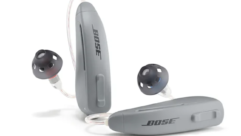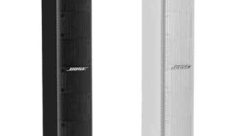THE RIGHT PRESCRIPTION
Jul 1, 2000 12:00 PM,
Jhon Meyer
Examining SIM System II, FFT measurement optimized for live sound applications.
Which audio measurement tool is best? It often depends on the situation. For example, picture in your mind an all-too-familiar situation faced by many contractors and consultants. You have just finished installing the sound-reinforcement system for the new metropolitan performing arts center – well, almost finished. The drywall and painting subcontractors were working behind schedule, so you had to rig temporary delay loudspeakers for opening night. Your initial main cluster alignment was done before the curtains and carpets went in. You were hoping for some late night quiet time for final tweaking, but the carpet and seating people worked overtime, too. Only two hours before the big opening show, a picky safety inspector made you move your temporary delays back 4 feet (1.2 m), more or less.
Now, it is 20 minutes until show time. Recorded music is playing. The crowd is filing in. The governor and mayor are also on hand to make sure tax dollars were well spent. Your system, however, is not quite ready, and you know it. You need accurate information, and you need it fast with only the music for your test signal. So, what kind of audio measurement tool do you want in front of you?
Benefits and precautions
SIM System II from Meyer Sound was designed and built specifically for such situations, but before examining SIM, for contrast, we will look first at the most common audio measurement tool – the 1/3-octave analyzer. This familiar device can be quite useful when all you need to do is gauge general energy distribution in the audio band. It provides a good overview of the spectral density of the information in the signal. In the absence of significant acoustical complications, 1/3-octave analysis can help determine whether or not your reinforcement system has the capability of passing information in each particular audio band with the same relative efficiency. Amplitude-only, 1/3-octave, data on this level can help you determine system configuration needs. For example, if you look at the energy distribution of a Luciano Pavarotti concert, you can tell that you do not need massive banks of subwoofers to carry the bass content.
You do, however, have to be careful with 1/3-octave analysis because much of the information that is clearly audible to the ear is not evident in the measurement data. For example, there is nothing in a 1/3-octave analysis that would allow you to distinguish between a measurement in a tile bathroom and one taken outdoors. It would not tell you much of significance when trying to define the interactions of fill loudspeakers and delay loudspeakers. Also, 1/3-octave analyzers do not distinguish between direct energy and reflected energy, which can be misleading in some circumstances. (See “High-resolution complex analyzers,” page 63.)
In sum, although 1/3-octave analysis can provide useful and true measurements in some circumstances, in other instances, the data provided falls short of the whole truth and nothing but the truth. Some people continue to work with 1/3-octave analysis, maintaining that it is sufficient, and going to higher resolution and incorporating phase analysis is too complicated. Unfortunately, sound is complicated. In more complex situations, it takes a lot of study and practice to make a system work right, and high-resolution data is an essential part of the process. You cannot just look at a 1/3-octave display, say it looks fine, and then pronounce that everything is all right. If your ears tell you something is amiss, then your job is not done or, at least, not done right.
Roots of SIM
The SIM System II is a measurement system that evolved from a series of experiments and field trials extending into the late 1970s. Our task was first to find techniques that could quantify and analyze what we actually hear when loudspeakers are placed in a particular acoustical environment and then to develop means for displaying that data quickly and meaningfully in time-critical field applications.
When you reproduce a source signal in a room, you create a complex transfer function, which defines the nature of the loudspeaker (plus amp and processing) along with the room acoustics. This transfer function involves a number of elements that can be characterized as room noise, reverberation, system distortion and frequency response (both amplitude and phase components). The starting point for SIM was looking at this complex transfer function and asking what we really care about and what parts can we really hear.
Frequency response is basic, of course, but at what resolution? In developing SIM, we ran exhaustive empirical listening tests and discovered that 1/3-and 1/6-octave were too broad, but at 1/100-octave, even golden ears strained to hear differences. Eventually, we concluded that a 1/24-octave resolution would be more than sufficient.
Do we also need phase information? Some audio tools leave this out, but we determined that phase information was absolutely essential in identifying and correcting a number of problems. If nothing else, phase information often reveals situations when conventional equalization techniques simply cannot solve the problem and might even further degrade the sound.
Available tools insufficient
As part of the SIM development process, Meyer Sound undertook an extensive review of audio and acoustic measurement tools available in the early 1980s. All displayed a range of strengths and weaknesses, depending on the task at hand, but it quickly became evident that none was ideally suited to fast, accurate optimization of complex sound-reinforcement systems in troublesome acoustic environments. True, these systems often worked quite well in the hands of experienced technicians who had several hours (if not several days) to acquire data and then interpret results. Alas, these approaches were practically useless in many time-critical situations faced by systems integrators and installers.
For example, two shows instrumental in defining SIM were the Luciano Pavarotti tour and the Broadway production of Les Miserables. On the Pavarotti tour, the large touring system had to be optimized quickly and accurately at sound check and then tweaked again as the audience filled the venue. Ideally, some final adjustments could be made during the 3 minute overture, but after that, no audible changes were allowed. Of course, the only allowable test signal in that circumstance was the actual music.
Les Miserables faced similar challenges, along with the difficulties inherent in productions using large numbers of wireless lavaliere mics on performers. Sound designers and mixers at the time struggled to get the sound right during rehearsals and then struggled again as the sound changed with the full house. The goal with Les Miserables was to get the sound right on opening night, not two weeks afterward.
These sound-reinforcement professionals needed a tool that was designed specifically for these situations. The tool had to be reasonably compact and portable, rugged enough to withstand touring, easy to set up and use, and capable of presenting data not subject to careless misinterpretation in the heat of the moment. Also, if at all possible, it had to offer useful functions when only music or voice could be used as the test signal.
Adapting FFT for live sound
Of the fundamental techniques available, FFT (Fast Fourier Transform) analysis offered the most promise. Overall, it was a good fit because it was fast compared to sine wave sweeps, and it was adaptable to solving nonlinear problems. FFT analyzers available at the time, however, proved generally unsuitable for a number of reasons. FFT analysis is inherently linear with equal resolution per frequency band (not per octave). Also, the accuracy of FFT analysis can suffer in noise environments with sparse excitation signals, requiring long averaging times to get accurate readings.
To address these deficits, Meyer Sound engineers implemented a constant Q transform, giving 24-point/octave resolution. SIM System II also includes proprietary algorithms designed to eliminate errors often generated by other systems when the excitation signal is statistically unpredictable or heavily contaminated with noise. Noise is defined here as any data components not in the original test signal, including reverberation. The first technique, signal thresholding, omits from the transfer function any signals that either fall below a specified threshold or overload the input at a particular frequency. Coherence blanking is a second technique that rejects effects of output noise, reverberation or other contaminants. Finally, vector and smart averaging removes both periodic and random noise contamination.
The eight-year SIM development process involved a number of decisions that determined the amount of processing power and the feature sets available in SIM System II. First, we knew from the outset that we needed to resolve the low-frequency characteristics of the room, and that required analysis essentially down to 1 Hz. With FFT analysis, you have to follow the reciprocal bandwidth rule, which dictates that for measurement down to 1 Hz, you need a time record of a full second. For example, if your time record is only 1 ms long, you cannot include any frequencies below 1 kHz. Extending resolution below audible limits required considerably more processing power, but we felt this was critical in obtaining meaningful results.
It is important to note here that SIM does not solve any problems by itself, but it was developed in tandem with the CP-10, which is a second-order symmetrical parametric EQ. During early SIM development trials, we found that use of 1/3-octave filters was problematic because peaks and dips did not necessarily appear neatly spaced on ISO center frequencies. Instead, loudspeaker interactions and boundary conditions generated response anomalies of widely varying character that needed specific corrective filters. As long as the anomalies were minimum-phase in nature (as 90% of them usually are), the CP-10 could provide a precisely matched solution.
Another important feature of SIM System II is that it deliberately does not attempt to analyze long-term late reflections. Although this information could be of use in designing acoustic treatments for a hall, these complex reflections are not minimum-phase phenomena and cannot be effectively handled by equalization, at least not in real-world concert situations. Consequently, late reflections are treated as noise and included in the display of S/N ratio (or its reciprocal, coherence) in SIM System II. This allows the operator to determine, at a glance, to what extent apparent problems can be addressed by equalization, or whether such alternate solutions as re-aiming loudspeakers, resetting delays or rebalancing relative subsystem levels need to be considered.
The final design goal, and the most difficult to realize at the time, was devising a means to achieve meaningful results using only music as the test signal. Fortunately, the computer was helpful in this regard, allowing us to store intermittent musical values that, when repeated, defined the transfer function of individual points, which were then combined to reconstruct the complete transfer function. For those interested in more background on the initial development and later refinement of the SIM technique, the technical details are available in two papers on the subject, “Equalization Using Voice and Music as the Source” (AES 76th Convention Preprint 2150 I-8, 1984) and “Precision Transfer Function Measurements Using Program Material as the Excitation Signal” (Proceedings of the AES 11th International Conference, Audio Test and Measurement, 1992).
Three engines
One feature that distinguishes SIM System II from many other measurement systems is its incorporation of three discrete DSP engines, allowing simultaneous analysis of three transforms. In practice, this allows a SIM operator to view simultaneously the unequalized response of the loudspeakers in the room, the parameters of the EQ and, perhaps most importantly, the combined result of the loudspeaker/room and the EQ. All three engines are necessary if you need a fast, unambiguous answer to the question, “Did my EQ solution do the job?”
Again, this is crucial because, although nine times out of 10 the prescribed EQ will solve the problem, the tenth time it may make it worse. If you have a delay loudspeaker out of sync, you need to get it back in sync first. Phase information is important here as well because if you look at amplitude only, you may think you have solved it, but you have not. It all boils down to getting the right solution and getting it fast.
The need for speed and accuracy also determined the necessity of making the SIM II multichannel version a complete hardware package with mic preamp and automated switching functions built into the system. This package deal is important for two reasons. First, when using music as a test signal, it is crucial that all elements of the system have known and stable transfer characteristics. Although you can use an external mixer or preamp to accomplish the same functions, the measurement system must then be calibrated for those particular external devices. Substituting an equivalent off-the-shelf external device or even using a different channel of the same device may or may not produce the same results.
Also, because such off-the-shelf devices as portable mixers are not designed for measurement applications, inadvertent operator errors are more likely when working under severe time constraints. For example, if levels on the test mic channels are misadjusted or mixer EQs inadvertently engaged, anomalies of just a few dB could result in erroneous measurements.
Truth in measurement
Again, SIM System II does not solve any sound reinforcement problems in and of itself. It is not an automatic equalization system, and it does not prescribe exact parameters for delay line calibration or adjusting relative subsystem levels. What it does do is provide the system operator with reliable, accurate objective data for making subjective decisions that affect the perceived quality of reinforced sound.
This is a crucial distinction because the declining cost of computer power and the widespread availability of digital EQs have made semi-automatic equalization an affordable proposition. Although such automated procedures may have some value when used with simple systems in easily characterized acoustical surroundings, they have limited value when confronted with complex systems in highly reverberant environments. A program that attempts to automate equalization decisions must take into account a multitude of subtle factors and then act on the data unambiguously. In contrast, the human brain is well equipped to integrate even the smallest anomalies and identify such phenomena as cancellations that should not be equalized. Computers still fare poorly in such circumstances. The subtle intermingling of objective analysis and subjective judgment remains a unique property of human intelligence.
In that sense, SIM System II is analogous to an X-ray machine at a hospital, or if you consider the multiple modes, it is a combination X-ray, ultrasound and MRI scanner. SIM can give you multiple views of the same condition, but it does not issue a diagnosis nor prescribe treatment.
A case in point: SIM System II’s delay finder will give you a precise reading of the propagation delay between the source loudspeakers and the measurement mic location. If you want to put a delay loudspeaker at the measurement point, then you instantly know your exact delay setting, but you may not want precise time alignment. For subjective reasons, you may want your delay loudspeaker leading or lagging by a few milliseconds. You can, however, make those subjective adjustments and evaluate them more quickly because SIM gives you the starting point instantly and accurately.
A comprehensive approach
SIM is a field tool that allows a skilled and knowledgeable operator to make informed decisions regarding sound reinforcement system optimization in specific settings, but SIM is of little value if the operator is not knowledgeable and if the reinforcement system is inherently flawed. One incident from the early days of SIM development illustrates the importance of a balanced, well-rounded approach. We were using a SIM and CP-10 prototypes at a concert by a well-known 1970s rock group that happened to be pushing the systems to the brink, and we noticed a huge peak at 4 kHz. We could not take it out with the 4 kHz filter because the overdriven system was not behaving linearly. In cases like this, automated EQ simply does not work. The solution must be found by a knowledgeable operator with access to high-resolution data and the ability to measure the results of any corrective actions immediately. Of course, the ultimate solution is to have loudspeakers that stay linear at the desired levels.
Although SIM System II has benefited from a number of hardware and software upgrades since its introduction, the essential operation and configuration remain unchanged. We believe this is a significant strength of the SIM approach because once operators become familiar with SIM operation, they do not have to relearn procedures every year or two. Again, close familiarity can be crucial when only minutes or seconds are available for evaluating system anomalies.
Today, SIM System II remains the tool of choice for hundreds of touring sound system operators, theatrical sound consultants and high-end system designers. The longevity of the SIM concept underscores the value of owning a dedicated tool that is robust, powerful and specifically designed to perform the necessary tasks with exceptional speed and accuracy.
We definitely do need high-resolution complex analyzers. In fact, you already have two of them – your ears. You will, however, benefit greatly by having additional objective information about a system. If you have a poor analyzer, then you will inevitably discard its information when it does not fit the reality perceived by your ears.
Bear in mind that the human ear does not hear sound as low-resolution amplitude only. It is obvious that we can perceive the order of things (phase response) and the direct-to-reverberant ratio as well as the amplitude response. If your analyzer cannot discern between these, you may be seriously misled. The example responses shown in Figure 1, Figure 2 and Figure 3 will clarify the need for high-resolution complex analysis.
Figure 1 shows a comparison of two loudspeaker systems when displayed with low-resolution amplitude responses only. The only substantial differences appear in the low-mid region, where response B has a peak, and the extreme high-frequency region, where B has dropped off. There is nothing shown here that would indicate that one of the two systems is utterly unintelligible while the other is crystal clear. There is also nothing shown that would indicate that an EQ would be totally incapable of correcting the differences between them.Figure 2’s screen shows the amplitude, phase and S/N ratio of system A in 1/24-octave resolution. Notice that the S/N ratio appears near the top of the screen at most frequencies. Such areas have high intelligibility and a high direct-to-reverberant sound ratio. The areas where the S/N ratio dips down are frequencies where cancellations have occurred due to echoes or interactions between loudspeakers. The presence of these echoes is confirmed by the phase response.
Figure 3’s screen shows the amplitude, phase and S/N ratio of system B in 1/24-octave resolution. Notice that the S/N ratio appears near the middle of the screen throughout virtually the entire mid- and high-frequency ranges. This indicates that the system is unintelligible and has a low direct-to-reverberant ratio. The overwhelming strength of these echoes is confirmed by the phase response, which shows huge variations. The amplitude response is so poor that most of the data has been blanked out because the S/N ratio is too low to make an accurate calculation. In actual fact, the data here comes from an under-balcony listening area with no direct sound path to the high-frequency horn. The conclusion of all this is that differences that are obvious to our ears are not seen by conventional low-resolution, amplitude-only analyzers.









